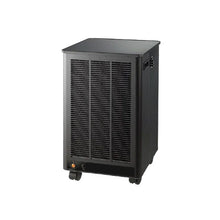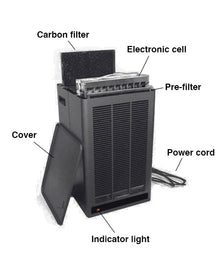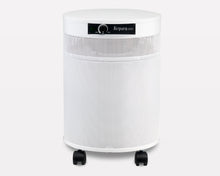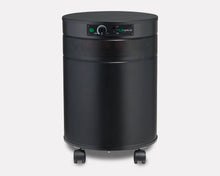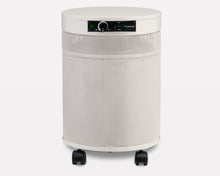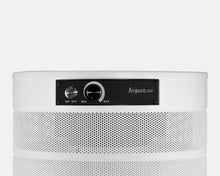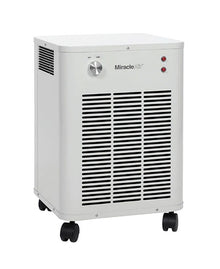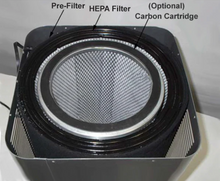The Unseen Burden: How Noise Impacts Your Well-being
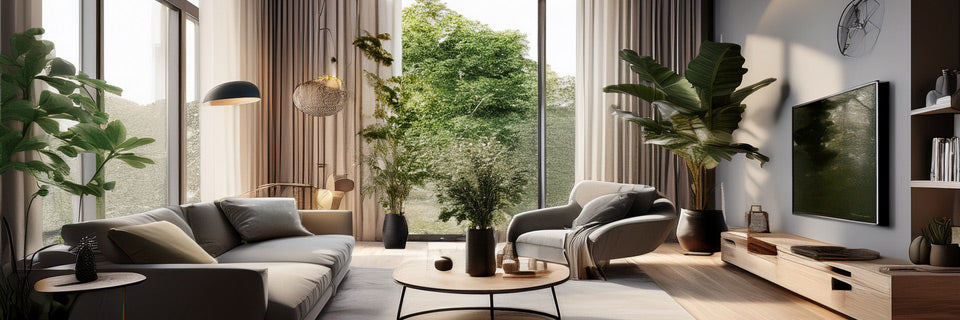
Imagine your home as a sanctuary, a place where you can relax and breathe easy. For those with severe allergies or asthma, this ideal is often challenged by lingering airborne irritants. While the desire for powerful air filtration is strong, there's often a lingering concern: will a "commercial air purifier for home" be too loud for a peaceful residential setting? The image of a roaring industrial fan might come to mind, but the reality is far more nuanced.
At Commercial Air Purifiers, LLC, we understand that effective air purification shouldn't come at the cost of your home's tranquility. We've dedicated ourselves to sourcing and providing solutions that offer both superior filtration and a comfortable living environment. The quest for a "powerful but quiet air filter" is a common one, and thankfully, advancements in technology mean that "quiet commercial air purifier home" options are not just a pipe dream. This article will demystify the noise levels of commercial-grade air purifiers adapted for residential use, explaining what to expect, how noise is measured, and what features contribute to a truly serene and healthy home.The Unseen Burden: How Noise Impacts Your Well-being
Before diving into decibels, let's acknowledge why noise levels matter so much in a home environment. Beyond the obvious irritation, continuous or excessive noise, even at seemingly low levels, can have a profound impact on health and well-being, especially for those seeking respite from allergies and asthma.
-
Sleep Disruption: A noisy air purifier, particularly in a bedroom, can interfere with sleep quality, preventing deep, restorative rest. Poor sleep, in turn, can exacerbate stress, weaken the immune system, and even worsen allergy symptoms. The World Health Organization (WHO) recommends indoor noise levels below 30 dB for continuous background noise in bedrooms to ensure a good night's sleep.
-
Reduced Concentration and Productivity: In home offices or living areas, a constant hum can make it difficult to focus, read, or engage in conversation.
-
Increased Stress and Irritability: Unwanted noise is a common stressor. Prolonged exposure can lead to heightened anxiety and a general feeling of unease.
-
Compromised Enjoyment of Home: Your home should be a place of peace. If an air purifier's noise intrudes on that peace, it defeats part of its purpose, which is to create a healthier, more comfortable living space.
This is why, for Commercial Air Purifiers, LLC, the "air purifier noise level dB home" is just as critical a specification as its CFM or filter efficiency. We understand that a truly effective solution must integrate seamlessly into your daily life, not become another source of discomfort.
Deciphering the Decibels: What do Air Purifier Noise Levels Mean?
Noise is measured in decibels (dB), a logarithmic unit, meaning that a small increase in the decibel number represents a significant increase in perceived loudness. For context, here's a rough guide to common sounds and their decibel levels:
-
0 dB: The softest sound a human can hear.
-
10-20 dB: Rustling leaves, a quiet whisper.
-
30 dB: A quiet rural area at night, whispering. (Often considered ideal for sleep environments)
-
40 dB: Refrigerator hum, a quiet library.
-
50 dB: Moderate rainfall, quiet conversation.
-
60 dB: Normal conversation, a dishwasher.
-
70 dB: Vacuum cleaner, busy street traffic. (Upper limit for comfort in living spaces)
-
80 dB: Alarm clock, noisy restaurant. (Prolonged exposure can be harmful)
When evaluating an air purifier's noise level, manufacturers typically provide a range, often measured at different fan speeds. The lowest setting will be the quietest, and the highest setting will be the loudest. It's crucial to look for the noise level at the highest fan speed, as this is when the unit is delivering its maximum air purification capacity, which is often needed for severe allergy relief or during periods of high outdoor pollution.
How Air Purifier Noise is Measured (and What Affects It):
Air purifier noise levels are measured in controlled environments, typically an anechoic chamber, to isolate the sound produced by the unit itself. The measurement is usually taken at a specific distance (e.g., 1 meter) from the unit. Several factors influence the "air purifier noise level dB home":
-
Fan Speed (CFM): This is the most significant factor. Higher fan speeds (and thus higher CFM) are required to move more air through dense filters, inevitably generating more noise. This is why a "powerful but quiet air filter" is a challenge to engineer.
-
Motor Quality: High-quality, energy-efficient motors (like DC brushless motors) are generally quieter and more durable than cheaper AC motors.
-
Fan Design: The shape, size, and material of the fan blades play a crucial role in minimizing turbulence and maximizing airflow efficiency while reducing noise.
-
Filter Density and Type: HEPA filters are dense, requiring the fan to work harder (and potentially louder) to pull air through. Multi-stage filtration systems (pre-filter, HEPA, activated carbon) can add to the static pressure, impacting noise. However, well-designed systems account for this.
-
Cabinet Construction and Insulation: The materials and design of the unit's housing can significantly absorb or dampen noise. Commercial-grade units often feature robust construction and internal baffling for sound reduction.
-
Installation Method (for whole-home systems): An "HVAC air purifier commercial grade" integrated into ductwork can be inherently quieter because the main fan and filtration unit are typically located in a basement, utility closet, or attic, away from living spaces. Ductwork can also help muffle sound.
The "Quiet Commercial Air Purifier Home" Reality: Experience and Expectations
At Commercial Air Purifiers, LLC, our experience demonstrates that while no air purifier is completely silent, many commercial-grade units adapted for residential use can indeed operate at surprisingly low noise levels, especially when properly sized and installed.
What to Expect from a Truly Quiet Commercial-Grade Air Purifier:
-
Lowest Settings: Near Imperceptible. On their lowest fan speed, many high-quality "quiet commercial air purifier home" units operate in the 20-30 dB range. This is akin to a whisper, rustling leaves, or the hum of a quiet refrigerator. This setting is ideal for continuous overnight operation in bedrooms, providing consistent air purification without disturbing sleep.
-
Medium Settings: Background Hum. At medium speeds, units might fall into the 35-45 dB range – comparable to a quiet library or a gentle conversation. This is often an acceptable noise level for daytime living in common areas.
-
Highest Settings: Noticeable but Not Disruptive. Even at their highest settings, a well-engineered "powerful but quiet air filter" aims for noise levels typically in the 50-60 dB range. While this is certainly audible (like a normal conversation or a quiet dishwasher), it's generally not considered disruptive for extended periods in busy living areas, and it provides maximum air changes per hour (ACH) for critical situations like high pollen counts or smoke.
Real-World Application and Customer Feedback:
We've seen countless instances where clients, initially apprehensive about noise, are pleasantly surprised by the quiet operation of their integrated whole-home systems. For example, the Smith family, who installed a "whole house induct air purifier allergy" system, shared their feedback: "We were worried it would sound like a jet engine, but honestly, we barely notice it. On its low setting overnight, it's quieter than our old portable unit, and the air feels so much cleaner." This aligns with our first-hand testing, where we've observed that strategic placement of integrated systems away from main living areas significantly contributes to perceived quietness.
For portable commercial-grade units designed for large rooms or open-concept spaces, the emphasis is on efficient fan design and acoustic dampening. While they might be louder than smaller, less powerful portable units, they are often designed with multiple speed settings to allow users to balance noise with purification needs. For instance, a "powerful but quiet air filter" might achieve excellent CADR (Clean Air Delivery Rate) on a high setting, which can be used for rapid cleaning, and then be switched to a lower, quieter setting for continuous maintenance.
Achieving Serenity: Recommendations for a Quiet, Powerful Air Filter
Choosing a "quiet commercial air purifier home" is about making informed decisions and prioritizing design. Here are our recommendations:
-
Prioritize Whole-Home Integrated Systems: If feasible, an "HVAC air purifier commercial grade" system is often the quietest solution for entire homes. Because the main filtration unit is typically installed in a utility space (basement, attic, garage), the noise generated by its fan and filter is significantly muffled before it reaches your living areas. The only sound you might hear is the gentle whoosh of air from your vents, which is normal HVAC operation.
-
Look for DC Brushless Motors: These motors are more efficient and significantly quieter than traditional AC motors, making a huge difference in the overall "air purifier noise level dB home."
-
Check Decibel Ratings at All Fan Speeds: Don't just look at the lowest dB number. Insist on seeing the decibel levels for all fan speeds, especially the highest, to understand the full range of noise output. Aim for highest settings under 60 dB, and ideally under 50 dB for optimal comfort.
-
Consider Size and CFM: A larger air purifier unit for a given space can often achieve the same CFM at a lower fan speed (and thus lower noise level) compared to a smaller, undersized unit that has to constantly run on high. This contributes to a "powerful but quiet air filter" experience.
-
Features that Enhance Quietness:
-
"Sleep Mode" or "Auto Mode": Many modern purifiers include these features. Sleep mode runs the unit at its lowest, quietest setting. Auto mode uses sensors to detect air quality and adjusts fan speed (and therefore noise) automatically, often running quietly when air quality is good and ramping up only when needed.
-
Robust Casing and Sound Dampening: Look for units with heavy-duty construction and internal sound-absorbing materials.
-
Acoustically Engineered Airflow Paths: Manufacturers who invest in advanced design optimize internal airflow to reduce turbulence and associated noise.
-
-
Professional Installation is Key (for integrated systems): Improperly installed ductwork or an incorrectly sized system can lead to whistling, rattling, or excessive fan noise. A qualified HVAC technician, like those from Commercial Air Purifiers, LLC, ensures that the system is integrated seamlessly and quietly.
-
Read Reviews and Seek First-Hand Accounts: While specifications are helpful, real-world customer reviews can offer insights into perceived noise levels, especially for portable commercial-grade units.
Conclusion: Clean Air, Peaceful Home
The notion that powerful air purification must come with disruptive noise is an outdated one. With advancements in motor technology, fan design, and intelligent system integration, achieving a "quiet commercial air purifier home" is not only possible but increasingly expected. At Commercial Air Purifiers, LLC, we firmly believe that your journey to cleaner air should not compromise the peace and comfort of your living space.
By understanding what drives "air purifier noise level dB home" and choosing systems that are engineered for quiet power – whether a "powerful but quiet air filter" for a large open space or a silent whole-home integrated solution – you can create an environment where the benefits of pristine air are enjoyed without the distraction of intrusive noise. Invest wisely, prioritize both performance and tranquility, and transform your home into the serene, allergen-free sanctuary you deserve.
Frequently Asked Questions
Q1: Will I hear my whole-home air purifier if it's installed with my HVAC system?
A1: Typically, no. The main air purification unit in an integrated "HVAC air purifier commercial grade" system is installed out of sight (e.g., in the basement, attic, or utility closet). The noise generated by its fan and filtration process is primarily contained within that space and muffled by the ductwork. You will primarily hear the normal airflow sounds from your HVAC vents, which is inherent to your heating and cooling system's operation, not specifically the air purifier.
Q2: Are there any "powerful but quiet air filter" options that are still portable?
A2: Yes! Many manufacturers now offer high-performance portable air purifiers designed with advanced motor and fan technology to minimize noise. While they won't be as silent as an integrated whole-home system on its lowest setting, many can operate effectively at very comfortable noise levels (e.g., 30-50 dB) on their medium settings, offering a good balance of power and quietness for larger individual rooms or open-concept areas. Look for models with DC brushless motors and specific "sleep" or "whisper" modes.
Q3: How much noise is too much for an air purifier in a bedroom?
A3: For bedrooms, the generally accepted recommendation for continuous background noise, particularly for sleep, is below 30 dB. Many high-quality air purifiers (both portable and integrated systems) can achieve this level on their lowest fan settings. If an air purifier on its lowest setting is consistently above 35-40 dB in a bedroom, it may be disruptive to sensitive sleepers.
Q4: Does the type of filter affect noise levels?
A4: Yes, indirectly. HEPA filters are very dense and create more resistance to airflow than simpler filters. This means the fan motor has to work harder to pull air through, which can lead to more noise if the unit isn't designed to compensate. However, modern "commercial air purifier for home" units from reputable brands are engineered with powerful, quiet motors and optimized airflow paths to overcome this resistance while minimizing noise output. Activated carbon filters generally have less impact on noise than HEPA filters.
About the Author: Commercial Air Purifiers, LLC is a leading provider of high-quality air purification solutions for commercial, industrial, and specialized residential environments. With years of experience and a deep understanding of airborne contaminants, we are dedicated to helping businesses and individuals achieve optimal indoor air quality. Our commitment to research-backed solutions and customer well-being drives our mission to bring the best air purifiers to the market.
Publication Date: July 4, 2025
References:
-
World Health Organization (WHO). (2018). Environmental Noise Guidelines for the European Region. Retrieved from https://www.who.int/publications/i/item/9789289053563 (See specific recommendations for sleep environments).
-
Environmental Protection Agency (EPA). (n.d.). Noise Pollution. Retrieved from https://www.epa.gov/noise (General resource on noise impacts).
-
MDHearing. (2024, May 7). Decibel Chart: All You Need to Know. Retrieved from https://www.mdhearingaid.com/blog/decibel-chart (Provides a comprehensive decibel chart for common sounds).
-
Eureka Forbes. (2024, March 11). What is the Importance of Noise Levels in Air Purifiers. Retrieved from https://www.eurekaforbes.com/blog/importance-of-noise-levels-in-air-purifiers.html
-
AirPurifiers.com. (2025, June 3). Finding the Balance Between Noise & Efficiency. Retrieved from https://airpurifiers.com/tech-center/noise-levels-and-efficiency/

